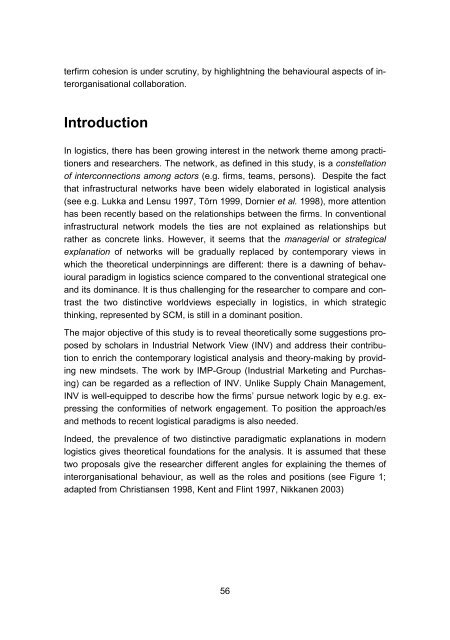849954 sisus
849954 sisus
849954 sisus
You also want an ePaper? Increase the reach of your titles
YUMPU automatically turns print PDFs into web optimized ePapers that Google loves.
terfirm cohesion is under scrutiny, by highlightning the behavioural aspects of interorganisational<br />
collaboration.<br />
Introduction<br />
In logistics, there has been growing interest in the network theme among practitioners<br />
and researchers. The network, as defined in this study, is a constellation<br />
of interconnections among actors (e.g. firms, teams, persons). Despite the fact<br />
that infrastructural networks have been widely elaborated in logistical analysis<br />
(see e.g. Lukka and Lensu 1997, Törn 1999, Dornier et al. 1998), more attention<br />
has been recently based on the relationships between the firms. In conventional<br />
infrastructural network models the ties are not explained as relationships but<br />
rather as concrete links. However, it seems that the managerial or strategical<br />
explanation of networks will be gradually replaced by contemporary views in<br />
which the theoretical underpinnings are different: there is a dawning of behavioural<br />
paradigm in logistics science compared to the conventional strategical one<br />
and its dominance. It is thus challenging for the researcher to compare and contrast<br />
the two distinctive worldviews especially in logistics, in which strategic<br />
thinking, represented by SCM, is still in a dominant position.<br />
The major objective of this study is to reveal theoretically some suggestions proposed<br />
by scholars in Industrial Network View (INV) and address their contribution<br />
to enrich the contemporary logistical analysis and theory-making by providing<br />
new mindsets. The work by IMP-Group (Industrial Marketing and Purchasing)<br />
can be regarded as a reflection of INV. Unlike Supply Chain Management,<br />
INV is well-equipped to describe how the firms’ pursue network logic by e.g. expressing<br />
the conformities of network engagement. To position the approach/es<br />
and methods to recent logistical paradigms is also needed.<br />
Indeed, the prevalence of two distinctive paradigmatic explanations in modern<br />
logistics gives theoretical foundations for the analysis. It is assumed that these<br />
two proposals give the researcher different angles for explaining the themes of<br />
interorganisational behaviour, as well as the roles and positions (see Figure 1;<br />
adapted from Christiansen 1998, Kent and Flint 1997, Nikkanen 2003)<br />
56








